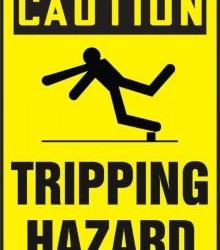9 tips for Preventing Slips, Trips and Falls

When prioritizing your safety efforts, it’s easy to put hazards that could result in amputations or fatalities at the top of the list and spend little to no time on slip, trip and fall hazards. After all, if a person—employee, customer or visitor—slips on a wet floor or trips on a cord, what’s the worst that’s likely to happen?
The fact is that even non-life threatening injuries, such as broken bones and torn ligaments can have a profound impact on a person’s life, and could result in being out of commission for a significant period of time. Not to mention, it could result in a costly lawsuit.
In addition, in many workplaces, it’s more likely that someone will slip or trip and fall than get caught in machinery, run over by equipment or injured by contact with hazardous materials.
The good news is that addressing slip, trip and fall hazards is usually easy and inexpensive to do. Here are nine tips to help you address such hazards in your workplace:
1. Implement good basic housekeeping practices. Keep area clean, with floors and access routes clear of obstacles.
2. Ensure adequate lighting levels, positioning lights to ensure all floor areas are evenly lit and all potential hazards, obstructions and spills can be clearly seen.
3. Regularly inspect for potential hazards. Check floors for damage and repair when necessary to address holes, cracks and loose carpets and mats. Ask employees to report any hazards they see.
4. Ensure that floor surfaces are suitable, such as resistant to oil and chemicals used. In areas where water is used, there should be drains.
5. Make sure stairways have handrails, slip-resistant covers on steps, high visibility and non-slip markings on the front edges of steps, and good lighting.
6. Clean up spills immediately using an appropriate cleaning method. Use warning signs where the floor is wet and arrange alternative routes.
7. When possible, remove any obstructions that could cause someone to trip or fall. If that’s not possible, then use appropriate barriers and warning notices.
8. Practice good cord management. For example, place equipment so power cords don’t cross pedestrian routes. And securely fix cords to surfaces.
9. Require workers to wear suitable footwear, taking into account the type of job, floor surface, typical floor conditions and the slip-resistant properties of the soles.
